Researching the Kids: Babies, Children, and Teens in the Family Tree
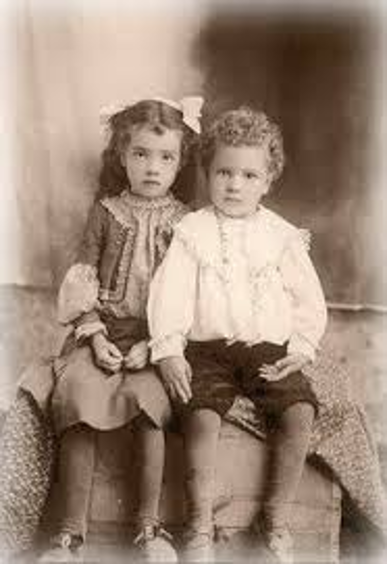
Why should you spend time researching the kids in your family tree? Simple! Children are the ones who make us ancestors, and all of our ancestors were children once. They generated records that allow us to trace them from the cradle to the grave. Plus, you may find family information via an ancestral sibling that you can’t find through your direct ancestor. Without the kids, no genealogical research is possible! Let’s start with regional attitudes and time periods that affect records documenting their lives.
Settlers in different regions of America brought their own ideas about childrearing with them from different parts of the world. Several factors contributed to these attitudes, including religion, social morés, ethnicity, class, and physical environment. The book Albion’s Seed: Four British Folkways in America by David Hackett Fischer provides an outstanding detailed look at these factors and is highly recommended reading. Fischer details the folkways of four groups of people who moved from distinct regions of Great Britain to the American colonies.
Virginia Dare
Virginia Dare was the first English child born in America (Fig. 1). Her birth was recorded by her grandfather, Governor John White, in his journal: “The 18 [August 1587] Elenor, daughter to the Gouernour, and wife to Ananias Dare one of the Assistants, was deliuered of a daughter in Roanoak, and the same was christened there the Sonday following, and because this child was the first Christian borne in Virginia, shee was named Virginia.”

Legal Status of Children
Children can be found in a wide variety of records, but because local laws affected the types of records in which they appear, we first need to understand laws affecting children in the historical periods in which they’re living. Such laws related to adoption, inheritance, servitude, bastardy, and other conditions, and they can vary by location. Knowing the laws of your colony or state of interest will help you determine what kinds of public records children may appear in, and many of these statutes are available online. First, let’s look at some legal terms pertaining to children that you should know:
- Infant: A child under 21 years old
- Orphan: A child under legal age (minor) who lost one or both parents; fatherless child
- Half-orphan: An older use of “orphan” (loss of one parent)
- Apprentice: A minor bound by law to a master to learn his art, trade, or business,and to serve him during apprenticeship
- Nepos: Latin term meaning “grandson”
- Son-/daughter-in-law: Could mean in-law or a step-relationship
- Natural son/daughter: Acknowledged child who had been born out of wedlock. The only meaning the phrase had in the law in that context back then was “a bastard; a child born out of lawful wedlock.” Also known as a “filius nullius,” or “child of no one.”
What Records Contain Information About Children?
Children appear in an abundance of records throughout American history. Many of these records have been published and/or digitized. They include:
- Censuses
- Mortality schedules
- Newspapers
- Diaries, journals, memoirs
- Adoptions
- Baby books
- Death records
- Poor farms
- Bible records
- Houses of worship
- School records
- Police records
- Military records
- Court records
- Orphanage records
- Organization records
- Passenger lists
- Naturalization records
- Family and county histories
Censuses – Federal and State
Before 1850 the only name on a census record was the head of household; everyone else was a mark or a number in an age/gender column, and no other questions were asked about them. By 1850 everyone in the household was named, and the questions asked about them varied with each census, such as whether they went to school, if they could read and/or write, their mental condition, etc. The 1870 census (column 13) and 1880 census (column 7) indicate the month in which the person was born, if born “within the year,” that is, between June 1, 1869 and May 31, 1870 for the 1870 census; June 1, 1879 and May 31, 1880 for the 1880 census.
One federal census was voluntarily taken in 1885, halfway between the 1880 and 1890 censuses, in New Mexico Territory, Florida, Dakota Territory, Nebraska, and Colorado. The same questions were asked. Some states also took their own off-year censuses, such as New York, Massachusetts, and Wisconsin, among others. Off-year censuses can identify children who were born and/or died between federal censuses.
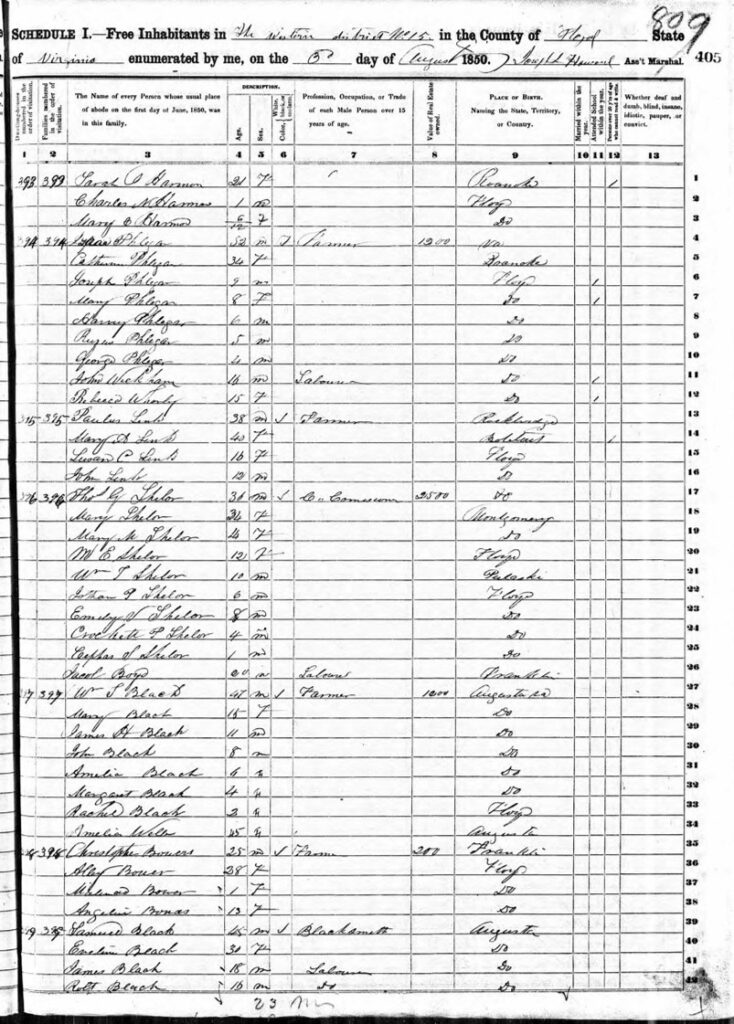
Federal censuses after 1850 also include state birthplaces, so not only can they identify children’s birthplaces; they also help track a family’s migration trail. In some very rare cases, enumerators recorded the state AND county of birth. For example, the 1850 enumerator of Floyd Co., Virginia included the county of birth for everyone born in Virginia (Fig. 2).
1880 Special Schedules
Check the regular 1880 schedule for tick marks in columns 16-19 and follow up with additional research in the 1880 special schedules relating to “defective, dependent, and delinquent classes.” You could gain possible new information such as institutionalization of children in a special school, orphanage, or poorhouse. The special schedules were created to record information for persons deemed at that time to be insane, idiots, deaf-mutes, blind, paupers, indigents, and homeless children. The schedules are on Ancestry.com; however, they exist for only 21 states.
Mortality Schedules
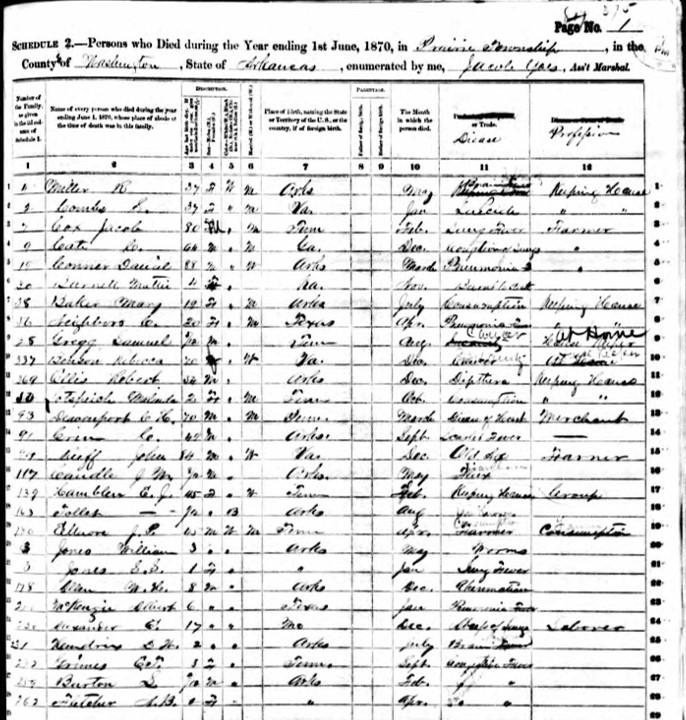
Of the 28 persons on this page, 13 are children aged 17 and younger.
Mortality schedules were supplemental schedules to the 1850-1880 federal censuses. They list persons reported to have died during the year previous to the census year: June 1, 1849 to May 31, 1850; June 1, 1859 to May 31, 1860; June 1, 1869 to May 31, 1870; and June 1, 1879 to May 31, 1880, and may include deaths of children born after the previous census but died before the current census year. Information includes name, age, cause of death, and month of death (Fig. 3). However, this information was not taken and/or submitted by all states for all years, and includes only deaths reported to enumerators. A dictionary of archaic medical terms will come in handy at this time. A good on-line glossary is Glossary of Medical Terms Used in the 18th and 19th Centuries.
Newspapers
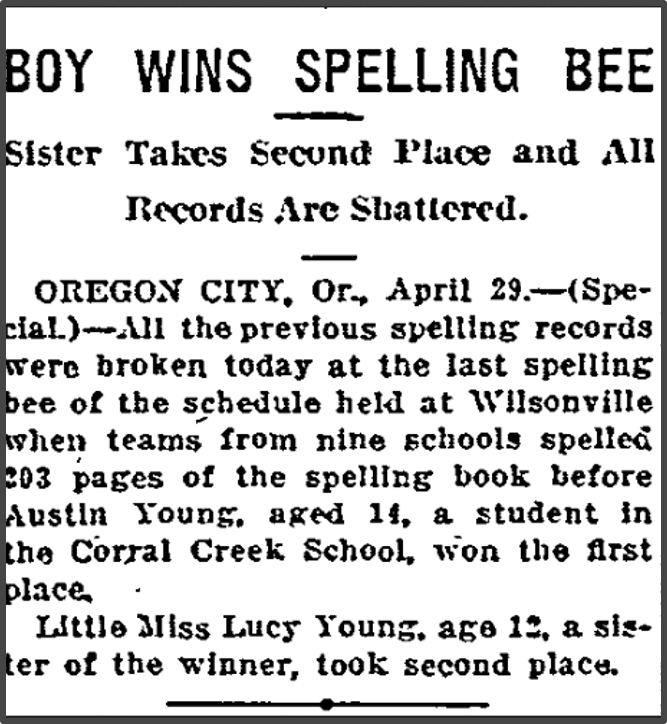
Oregon), April 30, 1914.
Newspapers are an extremely valuable source for news about children, and in some cases they may be the ONLY source. They may also provide valuable clues to follow up with research in other sources. Information ranges from births and deaths to high school graduations, sports and social activities, and other news pertaining to children (Fig. 4). They may include pictures, especially in issues from 1900 forward. Published obituaries and death notices could be the only record of a death before death certificates were available.
Large numbers of newspapers have been digitized and made searchable on free and subscription web sites. Subscription sites include Newspapers.com, NewspaperArchive.com, and GenealogyBank. The library subscribes to the first two and you can use them any time it is open. Some free sites include Chronicling America, Veridian, and TheAncestorHunt. The last one is a portal to newspapers on the web; it doesn’t contain the papers themselves.
Diaries, Journals, Memoirs
Births, illnesses, and deaths may be recorded in family diaries and journals, and you should ask family members if they have them or know of them. Sometimes these sources are transcribed and published in genealogical journals. Outside of the family, they be in manuscript form in a historical repository. Check resources such as the National Union Catalog of Manuscript Collections (NUCMC), ArchiveGrid, or OCLC WorldCat for location of manuscripts. Before attempting to use NUCMC, be sure to read the FAQ page. Also, check the Periodical Source Index (PERSI) for access to genealogical periodical articles. The Chadwyck-Healey Index to Personal Names in the National Union Catalog of Manuscript Collections, 1959-1984 (2 vols., 1988), and Index to Subjects and Corporate Names in the National Union Catalog of Manuscript Collections, 1959-1984 (3 vols., 1994) provide a way to search for names in manuscript collections. ArchiveGrid contains archival material descriptions and repositories holding them. WorldCat is a world-wide library catalog where you can find out which institutions have items of interest. Google Books and Internet Archive contain many full-text items no longer under copyright. Lastly, try a Google search using “digital collections” or “digital library” and your place name if you’re checking on items in a particular location.
Adoptions
Finding information about adoptions can be a sticky wicket, depending on the time and place. Formal and informal adoptions took place in earlier times, but formal adoptions are a relatively recent phenomenon. Many times children were simply “farmed out” or taken in by relatives and neighbors if they were suddenly orphaned or could not be cared for by parents. Laws pertaining to adoption vary by state and over time. The notion of formal adoption (under the law) didn’t even begin in the US until the 1850s (Fig. 5).

Illinois, 1875.
If a child was placed with a state agency or private organization, documents pertaining to this action usually contain helpful hints such as data on other siblings, names of birthparents, and other descriptive information. Birth certificates normally provide names of birthparents and the child’s birth name. Amended birth certificates provide names of adoptive parents and child’s adoptive name. Census records from 1880 onward contain a relationship column. If you spot the letters “AD” in front of “son” or “daughter”, this means, if correct, that he or she was adopted.
Where one or both parents die leaving minor children, the court can appoint a guardian to care for children. In many instances, guardians are family members. In the 19th century this can be a clue to adoption. Court petitions to change names can also indicate an adoption. Probate courts often handled guardianships and adoptions. Wills help clarify relationships if the testator or testatrix laid them out.
Hospitals maintain birth records for infants and birthmothers. If you know the name of the hospital where a baby was born, this might provide additional information. In earlier newspapers you may find a legal section for notices relating to adoption hearings or ads trying to establish paternity.
In some states the General Assembly accepted adoption petitions from prospective adoptive parents that contain the child’s birth name and names of the adoptive parents. Many historical state legislative records can be found with a Google search.
Baby Books
Depending on how well they were kept up, baby books can be a source for infancy and childhood information not found anywhere else, such as hair and eye color, length and weight at birth, growth milestones, photos, keepsake cards, notices, clippings or mementos.
Death and Burial Records
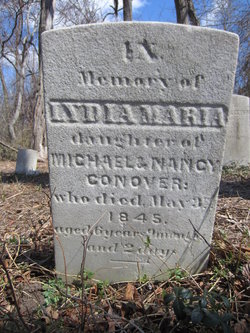
Maria Conover, age 6, Lequier-
Van Brackle Family Cemetery, Holmdel, Monmouth Co., New
Jersey, Findagrave.com
Death and burial records may be available in various forms depending on the time and place. Death certificates were not common until well after 1900, although many localities issued them before that date. Church and civil death registers were kept in some localities, as well as cemetery or sexton’s records. A sexton was responsible for keeping a cemetery’s records as well as maintaining the cemetery. You can find free on-line cemeteries at Findagrave.com, Interment.net, and BillionGraves.com (Fig. 6). Funeral home records are also a great resource where they exist.
Poorhouses
Children may appear in any category of people usually found in poorhouses or county farms. These include homeless families, destitute families, victims of domestic abuse, unwed mothers, orphans, handicapped people, and sick people. The federal census usually treated the poorhouse as a household, and in that household, might have listed employees (i.e. Keeper or Superintendent, and his family, and other people who may have worked in the poorhouse doing laundry, farm work, etc., as well as inmates. The inactive but still helpful web site Poorhousestory.com is a good resource and is available at the Internet Archive.
Bible Records

Bible records are well-known for containing birth, death, and marriage information for immediate and extended family such as nieces, nephews, and grandchildren (Fig. 7). Sometimes relationships are stated in those records. Be sure to evaluate the handwriting style and ink color in terms of determining the record’s accuracy.
Churches and Synagogues
Houses of worship may have various records of events relating to local children, such as baptisms or christenings, confirmations, burials, Sunday school attendance, vestry books (Virginia), whether they were living with a widowed mother, being kept by a guardian (“off the parish”), or as disabled and living with a parent (Fig. 8). Various denominations also have central archives for research.
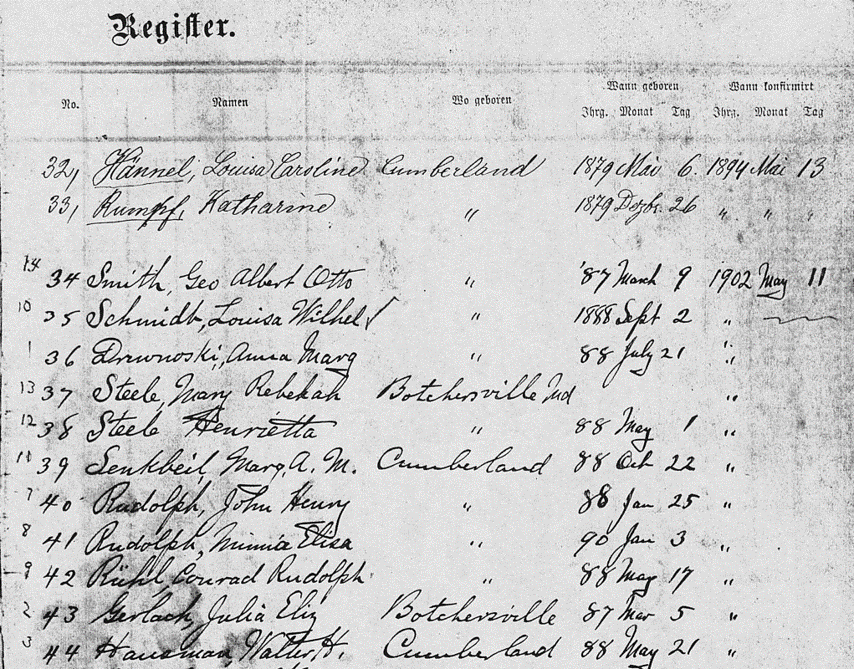
German Evangelical church
Schools
School records can provide information about children’s education and academic experiences. You many find various types of certificates relating to awards, recognitions, or participation in school events (Fig. 9). Diplomas, report cards, and yearbooks can also reveal children’s educational experiences and involvement. Many school yearbooks have been digitized and placed online at free and subscription web sites. Other records may be in state or local archives.
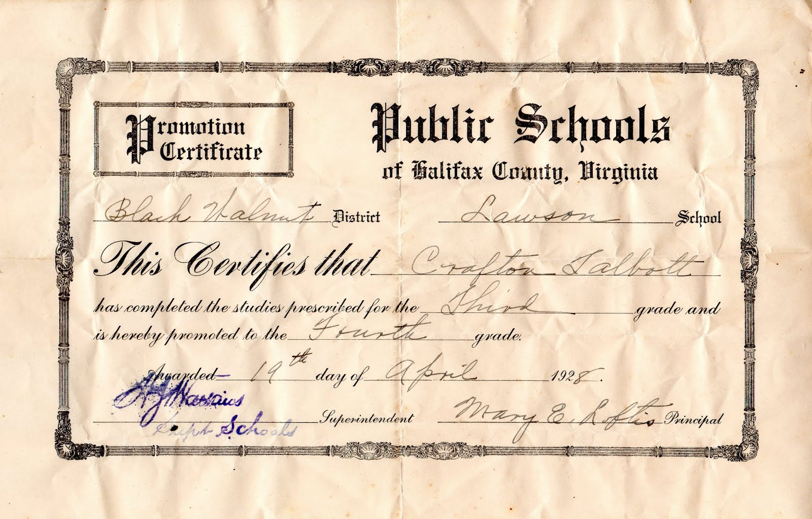
Police Records
Juvenile court proceedings were closed to the public and juvenile records were to remain confidential so as not to interfere with the child’s or adolescent’s ability to be rehabilitated and reintegrated into society. The very language used in juvenile court underscored these differences. Juveniles were not charged with crimes, but rather with delinquencies, and were sent to training schools or reformatories. Reformatories were recorded in censuses. You can also find many of them using “Reform school records” in a Google search (no quote marks). They may also be in state or local archives.
Military Records
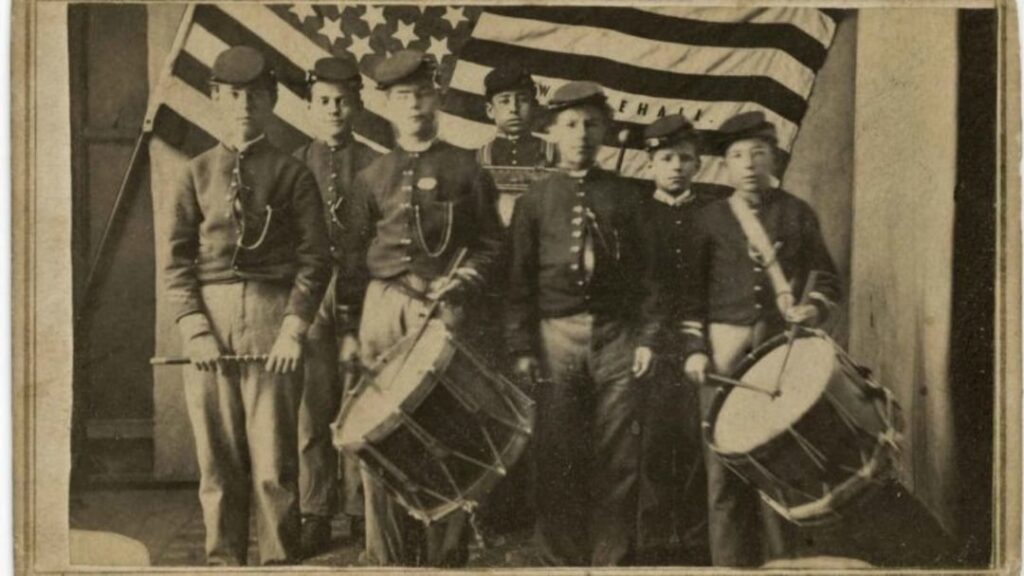
101st Pennsylvania Infantry Regiment, 1862.
Boys under eighteen served as drummers and fifers in the Revolutionary and Civil Wars (Fig. 10).
Service records from these wars don’t do well in identifying their ages since the records are undated and contain very few personal descriptions. If the person applied for a pension, more information about them may be included; however, their ages may or may not be accurate. At the library, using the Fold3.com military database, you can use the advanced search and enter “fifer”, “drummer”, or “musician” in addition to names. Some true Revolutionary War pension transcriptions can be searched on line at http://revwarapps.com, which has pensions emanating from service in the Southern campaign only. Minor boys serving in a naval capacity can also be searched on Fold3.
Court Records
As previously mentioned, different types of courts dealing with minor children existed before and after the American Revolution that involved apprenticeships, bastardy bonds, orphans, probate, and adoption. Children can appear in a variety of court records. The age of minority was usually under 21 for boys and under 18 for girls. The Orphan’s Court was predominant in Delaware, Maryland, New Jersey, and Pennsylvania (Fig. 11). The term derives from the old City of London’s Court for Widows and Orphans. Lord Baltimore brought this system to the Maryland colony. It dealt with probate matters but also had jurisdiction of “estates and persons of orphans.”
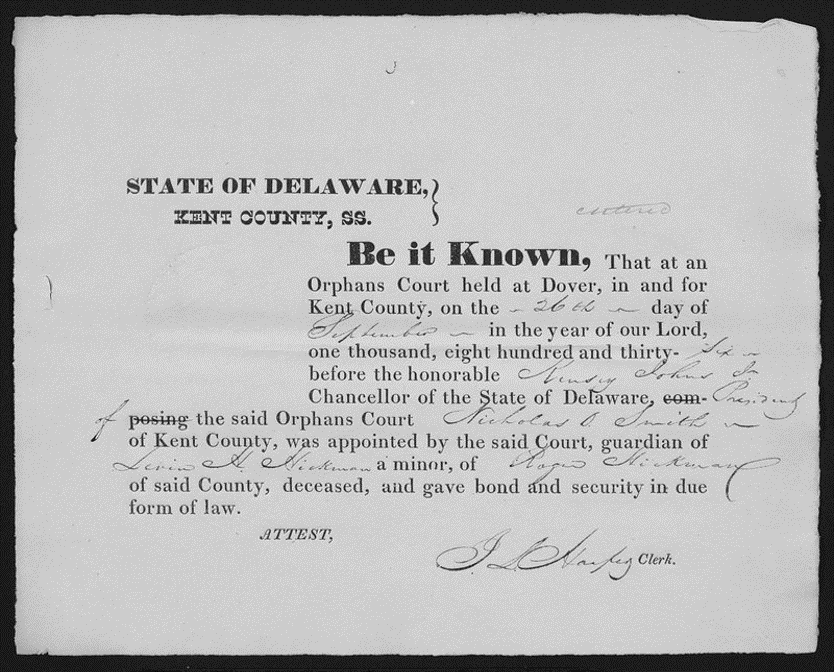
Delaware, 1836.
Orphanages and Orphan Trains
In 1800, there were no more than seven institutions in America for parentless children. By 1880 over 600 existed, and by 1910, over 100,000 children resided in American orphanages. These places may also be known as asylums or homes. Some were children of parents who were still living but had problems with finances or alcohol, and found institutions safer and better than life at home. In federal census records an orphanage resident was referred to as an “inmate”. The institution name is written at the top of schedule. You can also Google the name of the institution if you know its name. Surviving records of closed facilities may have been sent to state archives. For an orphanage run by a religious group, you can search online for denominational archives. Historical societies, local libraries, or Family History Library microfilm should also be checked.
If you think your ancestor was on one of the trains that transported orphaned children from Eastern cities to adoptive families in the West, explore orphan trains. The genealogy of many of these 200,000 orphaned, abandoned, or homeless children can often be traced back to the Children’s Aid Society, or the New York Foundling Hospital, among others. More information can be found in these places:
- Children’s Aid Society in New York City does paid archive searches for adoptions, and orphan train riders. You MUST contact them first, as they have many rules and regulations. The time period covers 1836-2006.
- New York Foundling Hospital can do records research for close relatives only of placed-out children. Covers 1869-2009. Ancestry has “U.S., Orphans Placed in the New York Foundling Hospital and Children’s Aid Society, 1855-1925” based on two books by Carolee Inskeep:
- The Children’s Aid Society of New York: An Index to the Federal, State, and Local Census Records of Its Lodging Houses (1855-1925). Baltimore: Genealogical Publishing Co., 2000.
- The New York Foundling Hospital: An Index to the Federal, State, and Local Census Records (1870-1925). Baltimore: Genealogical Publishing Co., 2004.
- National Orphan Train Complex, Concordia, Kansas helps find foster children between 1853 and 1930 who rode trains from New York City, Boston, or Chicago to new homes in other states or Canada.
Organizations and Clubs

Duluth, Minnesota.
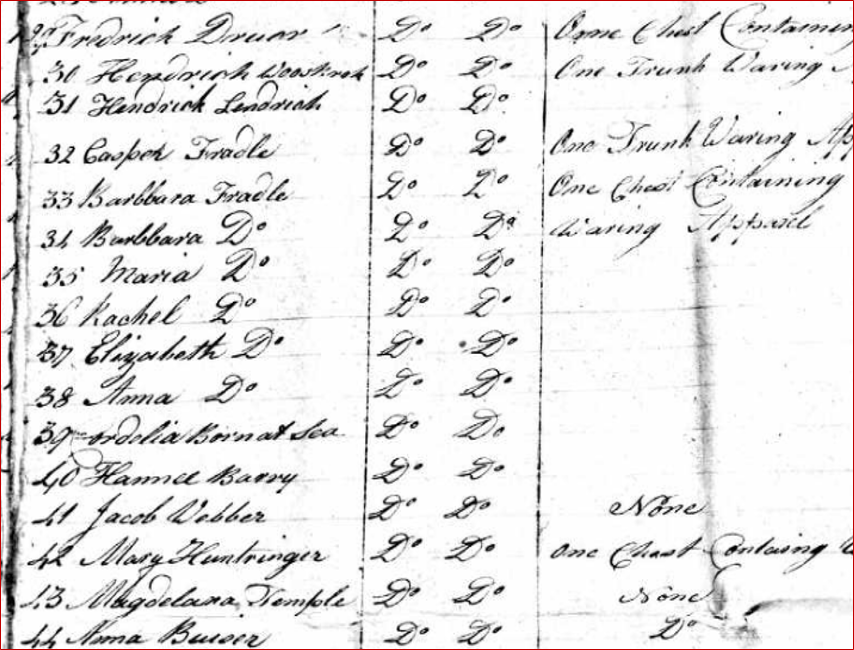
Philadelphia from Amsterdam, October 22, 1806.
Baby Cordelia (#39) apparently named for the ship.

Massachusetts on his Petition for Naturalization, 1929.
Later newspapers frequently carried stories about the activities of children’s and teen organizations (Fig. 12). Local organizations still in existence may have archival material or may have donated it to a local historical society or library. National organizations may also have archives of historical information about organizations.
Ship Passenger Lists
Children on ship passenger lists are normally found with their parents or other family members. In early records they may be identified by first names and/or ages, or simply as statistics. Some early lists also noted births and deaths at sea (Fig. 13). More detailed information about children occurs in late-nineteenth and early twentieth-century lists, such as birthplaces and physical descriptions.The free site FamilySearch has an excellent portal to numerous web sites offering free and subscription access to US passenger lists and border crossing information. You’ll need to set up a free login and password.
Naturalization Records
Until 1940, minors under 21 gained citizenship from their parents. They were not named in naturalization records until September 1906, when the federal government standardized the previously variable naturalization process. After that time, children’s’ names, birthdates, and birthplaces can be found on the father’s petition for naturalization (Fig. 14), or, after 1922, when women had to petition separately, on their mother’s petition as well. Again, FamilySearch has a great portal to naturalization and citizenship records on the Web.
Family and County Histories
Well-documented family histories can provide a wealth of information about children and can be digital, printed, or on microfilm. If they are not well-documented, information in them should be correlated with additional resources and verified before adding it to your family tree. A good way to discover what childhood was like at a certain time is to read county histories of that period. You many find references to activities in which children might have participated or what their schooling was like. Gaps in specific family records can be filled with broader social history information like this. Many family and county histories have been digitized and made available for free at Google Books, Internet Archive, HathiTrust, and by conducting regular Google searches. If you have a Grapevine Library card, you can also find them at HeritageQuest Online, available via the library web site.
Remember the Kids!
Preserving stories of children of the past is a reminder to preserve stories about our own children. They will help stimulate present and future generations to take more interest in their family histories.





Recent Comments